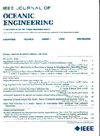Dynamic Analysis of the Cable-Releasing Phase for the Underwater Glider on Mooring Mission
IF 5.3
2区 工程技术
Q1 ENGINEERING, CIVIL
引用次数: 0
Abstract
The blended-wing-body underwater glider (BWB-UG) represents a novel mobile ocean exploration platform. In order to enable the device to perform long-term monitoring at fixed locations, a mooring mission with a cable is proposed. The cable-releasing phase represents a pivotal moment in the mooring mission, as it determines the success of the mission and the stability of the multibody system in motion. Consequently, this article examines the dynamics of the BWB-UG during the cable-releasing phase. A mathematical model of the cable release strategy has been established. A solution algorithm for the cable length increase is established based on the concentrated mass method and the multibody dynamics method. The analysis of the factors influencing the multibody system during the cable release phase has been completed. The effects of three movement patterns, namely downward gliding, upward gliding and straight navigation, are analyzed. The impact of ocean current magnitude and direction on the system is analyzed. The impact of the cable laying position and quantity on the system is analysed. The mechanism of the factors influencing the dynamics of the multibody system during the cable-releasing phase is elucidated.水下滑翔机系泊解缆阶段动力学分析
混合翼体水下滑翔机(BWB-UG)是一种新型的移动海洋探测平台。为了使设备能够在固定位置进行长期监测,提出了用电缆系泊的任务。解缆阶段是系泊任务中的关键阶段,它决定了任务的成功和多体系统运动的稳定性。因此,本文研究了BWB-UG在电缆释放阶段的动力学。建立了索释放策略的数学模型。基于集中质量法和多体动力学方法,建立了索长增加的求解算法。完成了多体系统在索释放阶段的影响因素分析。分析了向下滑行、向上滑行和直线航行三种运动模式的效果。分析了海流的大小和方向对系统的影响。分析了电缆敷设位置和敷设数量对系统的影响。阐明了多体系统在放索阶段的动力学影响因素的机理。
本文章由计算机程序翻译,如有差异,请以英文原文为准。
求助全文
约1分钟内获得全文
求助全文
来源期刊

IEEE Journal of Oceanic Engineering
工程技术-工程:大洋
CiteScore
9.60
自引率
12.20%
发文量
86
审稿时长
12 months
期刊介绍:
The IEEE Journal of Oceanic Engineering (ISSN 0364-9059) is the online-only quarterly publication of the IEEE Oceanic Engineering Society (IEEE OES). The scope of the Journal is the field of interest of the IEEE OES, which encompasses all aspects of science, engineering, and technology that address research, development, and operations pertaining to all bodies of water. This includes the creation of new capabilities and technologies from concept design through prototypes, testing, and operational systems to sense, explore, understand, develop, use, and responsibly manage natural resources.
 求助内容:
求助内容: 应助结果提醒方式:
应助结果提醒方式:


